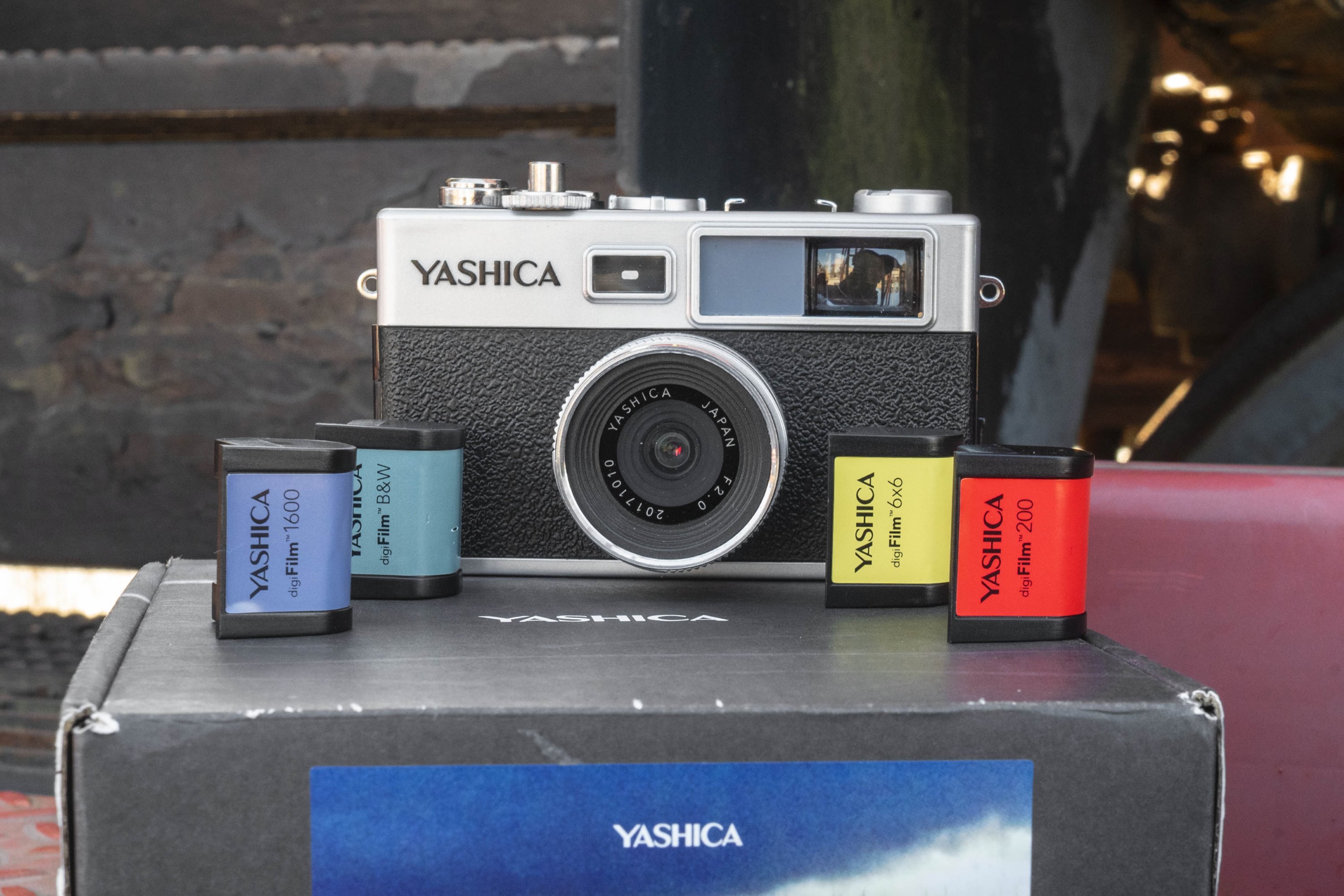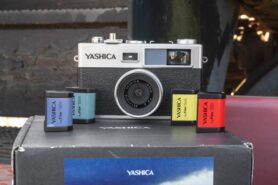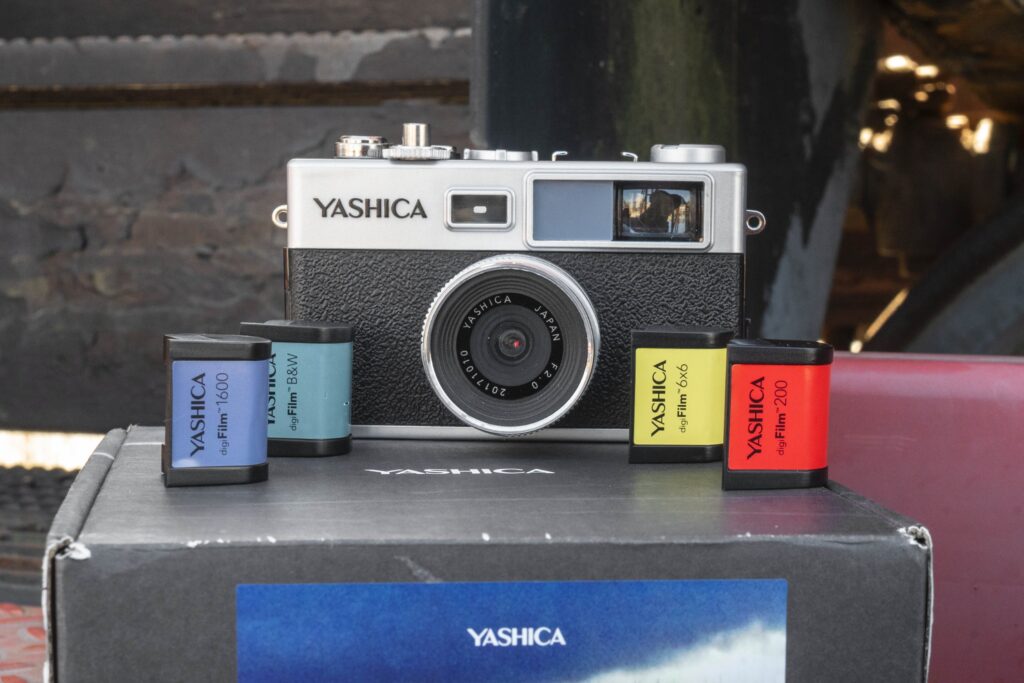This is a Yashica digiFilm camera Y35, a compact digital camera made by 100 Enterprises International Group Company Limited in Hong Kong, China. The camera was announced and crowdfunded on Kickstarter from October 2017 until its release in 2018. The Yashica digiFilm camera Y35 evokes nostalgia through use of the Yashica brand name and an appearance which resembles a smaller version of the classic Yashica 35 Electro rangefinder camera. The camera shoots 14 Megapixel images using a 1/2.5″ CMOS sensor onto standard SD memory cards. It is designed with retro styling, adding things like fake mechanical knobs, an advance lever which must be activated in between each exposure, and no LCD or EVF to preview or review your images. One of the camera’s biggest, and most controversial features is the use of “digiFilm” cartridges which load into the back of the camera, similar to an APS film cassette, which change the camera’s various modes. Settings like color, black and white, ISO, and image quality are entirely controlled by these cartridges, and cannot be changed on the camera itself.
Sensor Type: 14.0 Megapixel 1/2.5″ CMOS
Storage: 1x SD/SDHC Card (32 GB Maximum)
File System: JPG
Lens: 6mm (35mm equivalent) f/2 Yashica coated 5-elements
Focus: Fixed Focus, Manual Suggests 100cm to Infinity Depth of Field
Viewfinder: Plastic Window
Shutter: Electronic Shutter
Speeds: 1/30 – 1/6000 seconds, 1 second mode by holding down shutter release
Exposure Meter: Unknown Type, Full Programmed AE w/ +/- 2 EV
Battery: (2x) 1.5v Alkaline or Rechargeable
Flash Mount: Yes, Only Works with Optional LED Flash Module
Weight: 242 grams (w/ batteries, module, and SD card), 188 grams (empty)
Manual: https://www.yashica.com/y35-learn-more
This review for the Yashica digiFilm camera Y35 represents the first time I have ever taken a look at a camera which was produced after this site was created. Over the past decade or so, a large number of crowdfunded photography projects have come and gone through sites like Kickstarter and Indiegogo. A large number of them have failed to reach funding, or if they did, problems arose in the ultimate release of the product, and for the few that actually made it into the hands of supporters, the end result was often underwhelming.
The Yashica digiFilm camera Y35 falls into that last category in which the camera was successfully funded and released, however upon receiving the first cameras, to say that the response from the online community was underwhelming, is an understatement.
Funding for the camera would begin on October 10, 2017, a date which is written on the camera’s packaging and in three locations on the camera itself. The first funding goal was set at 1 million Hong Kong Dollars and it reached that goal in only 4 hours. The initial reaction of a new Yashica camera with attractive styling that resembled the very successful Yashica Electro 35 rangefinder, and an f/2 lens with 14 MP sensor intrigued the photographic community. Long have people been looking for a truly retro digital camera, and the promise of interchangeable cartridges which altered the digital images created a huge buzz.
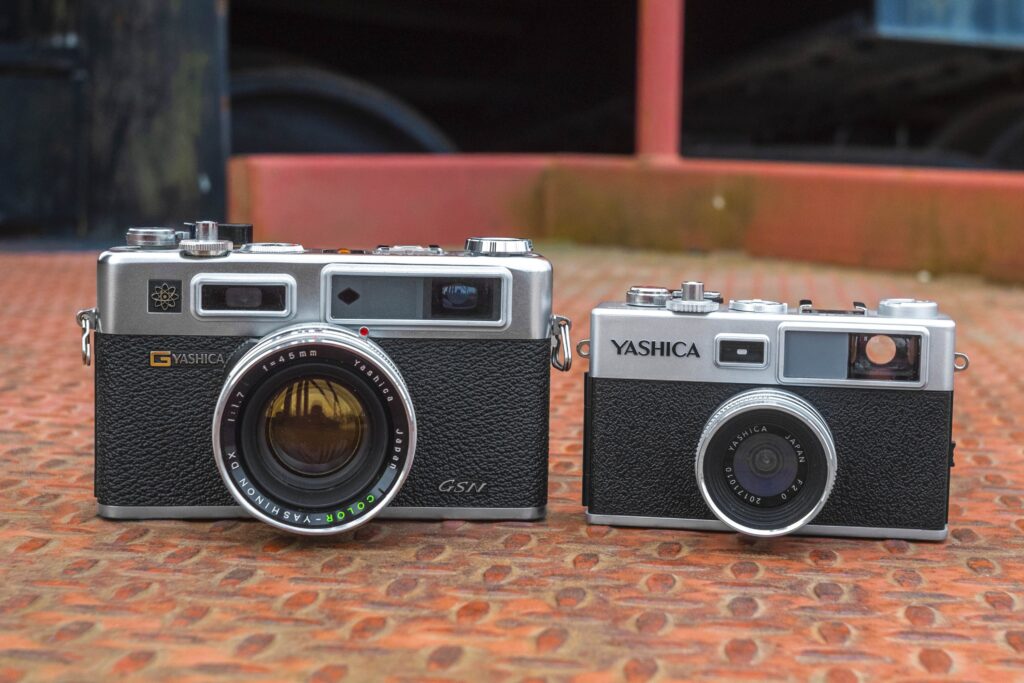
In addition to the camera, a premium version with a genuine leather body covering was announced, along with a number of leather accessories like a camera case, and a holder for the digiFilm cartridges. The announcement of these premium accessories on a slick website with nicely photographed images of camera prototypes offered a glimpse into what many hoped would be a return to quality Yashica cameras of yore.
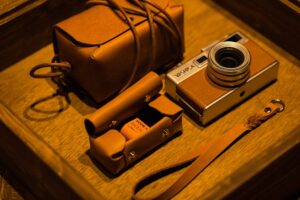
To their credit, the people behind the new Yashica camera were very communicative in the early days, giving regular updates, sometimes multiple times in the same day. Sample images and a couple videos of prototype cameras in action were shown, further increasing interest. After the initial positive response, a stretch goal of 10 million HKD (roughly $1.2 million USD) was revealed, as were several other tiers of camera, some with special packaging, unique cartridges, and even a special edition with a brown leather body covering. As I write this article in early 2025, the original Kickstarter page for the Yashica digiFilm camera Y35 is still up as are all the announcements. In total, 60 announcements have been posted, the most recent from December 2024, suggesting the team behind the camera is still engaging with the community.
As time went on, more and more technical details about the camera were released. The 10 million HKD stretch goal was met. An original spec sheet revealed a tiny sensor, which in November 2017 was upgraded to a larger 1/2.5″ sensor further exciting fans. In February 2018, an announcement revealing an April 2018 release date threw the film and digital communities into a frenzy. Articles appeared on all the top film and digital sites with excitement over the looming release of the new camera.
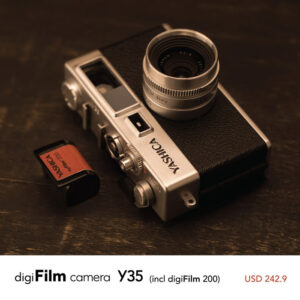
It was around this time where questions about the camera’s build quality were brought into question. While everyone wants an inexpensive but high quality camera, the reality of bringing any new product to market costs a lot of money and new digital cameras typically fetched prices of $500 and up. Delays pushing back the availability of the camera were expected, and in July 2018 a retail price of $242.90 was announced.
While affordable, the sub $250 price concerned some that the new Yashica would be nothing more than a toy with a smartphone sensor inside. Still, the Yashica team gave regular updates, showing off sample images which generally impressed most people. Confidence was still high.
Finally, in August 2018, the day came that shipments of the camera were going out to the people who backed it and the first hands-on reviews started to trickle in.
The knee jerk reaction of the camera was polarizing to say the least. While many people were pleased with the lightweight and easy to carry plastic body, many others felt the cheap feeling plastic would not be durable and that it made the camera feel like a toy. While the Yashica team developing the camera was very clear about the operation and features of the camera, that the only control was an EV compensation dial and there was no way to change any other setting of the camera except by use of the plastic cartridges, bothered many people. The concept that a digital camera could work like a film camera where the ISO, color type, and quality of image was determined by which film you loaded in it, was an intended characteristic of the Yashica digiFilm camera Y35, yet many people didn’t seem to “get it”.
In my research for this review, I read more than a half dozen reviews from late 2018 and early 2019 written by a variety of photo blogs and websites to wrap my head around what people thought of the camera when it was first released. A small sampling of quotes from those reviews are:
- Canny Cameras UK – “…it can take usable shots if you are aware of its limitations. It’s more able than proper toy digitals but struggles to escape that tag. Mines also has been more robust than you might think.”
- 35mmc – “…the Yashica Y35 is still too pricey. For the money I’d have expected more feedback, better sensor and a bit better build quality. I had also hoped for some more control than we got. The Maker’s response until the last 48 hours to concerns have been quite poor. I guess the Yashica Y35 team were hoping for a cult status like a digital LC-A. The negative press seems to have killed off any chance of that.”
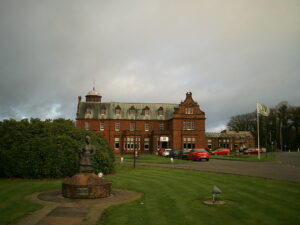
A sample image shot with a Y35 from a review by 35mmc.com. Image courtesy, 35mmc.com. - PetaPixel – “If you were skeptical of the Yashica Y35 Kickstarter and didn’t back it while it was the talk of the photo world, congratulations: you dodged a bullet with this one.”
- Best Light Photo Blog – “There is no doubt – it is a plastic camera. Yes it is. Is it a little rough in places? Sure. If you are expecting something more than what it was advertised…then you might need to go back and re-read the Kickstarter and set expectations accordingly. However, the whole Kickstarter community is a different topic for a different post. It very well could be that this camera may not be something I use all the time. It may only be good to use in good light. It might be total rubbish to some. Everything needs to be taken into perspective.”
- The Phoblographer – “I think that the Yashica Y35 is a nice learning tool for a photographer who needs it. Otherwise it’s a toy. I genuinely knew that I’d be taking this risk going in and backing the campaign. I’ve seen some serious vitriol spilled at people who backed the campaign with the same fervor of political conversations that I see on Facebook. But I’d like to remind the world that this is a camera, it isn’t that serious, and Yashica should be given points for doing something that the Japanese have been refusing to do for a very long time.”
- The Sajin – “This project was never meant to give everyone a 2018 version of the Electro 35 and that must be stated. Also note that this is not even made by the same company that made that legendary camera either. This was a project that started out with a half-baked idea and followed through with a half-baked product. It is as simple as that. Does it work? YES. Does it do what Yashica said it would? YES. However, it also just feels thrown together the way that you would find a “digital retro camera” in a novelty store. In the future versions, Yashica needs to up their game and put together a fully formed camera.”
- Other Random Comments: “I regret the day I paid for this. If film is dead, this shit makes film even dead-er. I would rather buy a broken APS film point and shoot than this shit. Literally, any camera is better than this. You can dislike my video, but seriously don’t even buy this camera.”
Perhaps the most damning criticism of the Yashica digiFilm camera Y35 came in the form of a tear down video published by Point & Shoot Club in which the camera is completely disassembled in a 25 minute video filled with a great deal of sarcasm and vulgar language. Despite the strongly negative vibe to the video, it is still interesting to see how simple this camera is. Perhaps the most surprising was that the camera has two metal plates inside the body which appear to serve no purpose other than to artificially inflate the weight of the camera. Considering the camera only weighs 188 grams without batteries, SD card, or cartridge, that it could have been even lighter is shocking to me.
The release of the Yashica digiFilm camera Y35 caused a lot of outrage from the film community about the camera’s cheap build quality and questionable performance. Many didn’t like the idea of the interchangeable digiFilm cartridges, or that the camera offered little exposure control directly on the camera. The viewfinder was just a straight through piece of plastic that didn’t accurately frame the image the lens would capture. Comments about the image quality seemed to take a back seat to the overall cheapness of the camera, but the ensuing years were not kind as most people simply forgot about the camera.
The Yashica digiFilm camera Y35 has never been on my radar. When this camera was first released in 2018, this site was still pretty small and back then I didn’t pay much attention to crowdfunded digital cameras. I am sure that at one point, I probably saw a post in one of the camera collector groups I was in about this camera and the overwhelming negative press it was receiving at the time, and whatever I might have read would have certainly disinterested me in it.
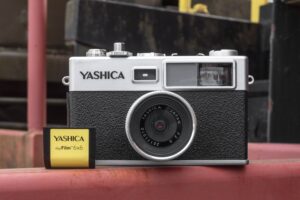
Fast forward to 2023 when I came across the collection of camera collector Kurt Ingham who had one of these in the original box. It had been opened and there was a memory card in the camera suggesting he had tried it at least once, but otherwise everything looked to be in “like new” condition. What intrigued me about the camera was not only the use of the Yashica name and styling that vaguely reminded me of the Yashica Electro 35, but that this was one of the first examples of an all new crowdfunded camera that actually met its goal and was released. I knew that there were many other crowdfunded cameras that never made it to release, so to have one that you could actually get your hands on seemed worthy of checking out. Considering the camera was already more than 5 years old when I came across it and it had some historical provenance, I decided to give it a review.
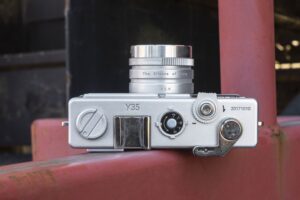
In preparation for this review, I took the time to read what others had already said about it online. Reviewing a camera released within the last decade means that there will be a great deal of info already out there, so I wanted to make sure I wasn’t repeating too much of what others have already said. On the other hand, there’s only so many things you can say about a camera, so in an effort to find that balance of what you probably already know, but without beating a dead horse, I’ll quickly summarize the things I agree with.
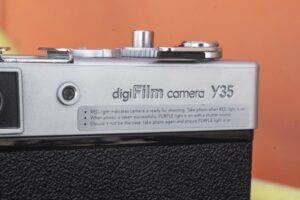
For starters, the Yashica digiFilm camera Y35 is very light weight and definitely feels like a cheap toy. What looks like normal camera body covering is hard plastic that somehow manages to feel slippery and textured at the same time. While point and shoot cameras have always had a larger use of plastics and other weight saving materials, a Nikon L35AF feels like a tank compared to this nearly hollow plastic camera. While reviewing this camera, I watched the Point & Shoot Club tear-down video and was shocked to learn that the camera’s 188 gram weight, includes several metal plates whose only purpose is to make the camera feel heavier. This was a tactic used by makers of many “scameras” or “trashcams” like the Big Royal View or the (not-Canon) Canon DL-9000 which used lead weights in the body of the camera to give an illusion of heft. Without these plates, the Yashica would probably weigh half as much!

In addition to the light weight, many aspects of the camera feel really flimsy in your hands. The most egregious is the rear door, which is where both the AA batteries and digiFilm cartridges go. The door is made of lightweight thin plastic with a very simple hinge pin holding it together. With the door open, it twists easily and although I haven’t tested its limits, feels like it would be very easy to snap off. Thankfully, there being no concerns over light leaks, it wouldn’t really matter if the door did break as the camera would still work without it. Another issue which presented itself while I was using it, is a black plastic tip on the end of the film advance lever fell off. I didn’t notice when this happened, so I couldn’t save it. You’ll notice that in images of the camera in this review, this piece is missing.
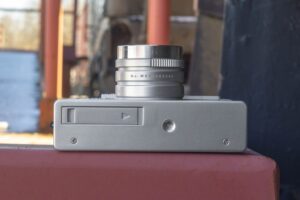
The bottom of the camera has an equally cheap feeling plastic door which opens to reveal the SD card slot and a micro-USB port for connecting the camera directly to a PC. The camera’s manual says that SD cards up to 32GB are supported as are UHS-I type cards. While 32GB would feel small compared to those supported by more professional digital cameras, I can’t imagine anyone would ever want to shoot 32GB worth of images in a camera like this. On the plus side, a 1/4″ tripod socket is present, which would come in handy for the camera’s 1-second long exposure mode.
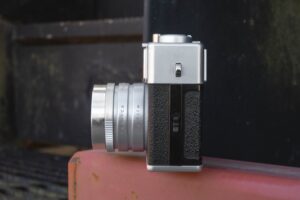
In addition to the door, nearly every tactile point of the camera feels cheap, the shutter advance lever is wobbly and lacks smoothness in its movement, the shutter release is not smooth throughout its travel, starting off with little to no resistance, then suddenly becomes difficult to press to fire the shutter, ending with a loud and unsatisfying CLUNK as it reaches the bottom of its travel. The viewfinder is a straight through plastic window where you can see inside parts of the camera through the rear eyepiece. There are no frame lines, focus aides, or any information about what the camera is doing. Quite simply, every part of the camera feels like a toy, which probably wouldn’t be so bad if the camera was a toy, but its marketing and “Yashica heritage” certainly suggested something better.
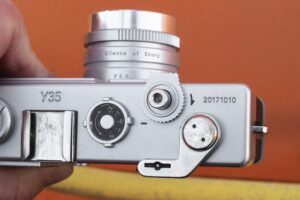
In terms of use, there’s little else to know about the camera. Besides changing the digiFilm cartridges, firing the shutter, and advancing the shutter, the only other control on the camera is an EV compensation dial which gives you a +/- 2 EV adjustment. There being no setting for manual exposure control or changing ISO speeds, this dial is the only semblance of exposure control the camera offers.
I’ll stop there and acknowledge that everything I’ve said thus far is stuff you can read about in all the other reviews of the camera out there. I don’t disagree with any comments about the camera’s cheap build quality, and I can imagine the level of disappointment first time users of this camera might have felt after so much hoopla leading up to the camera’s release.
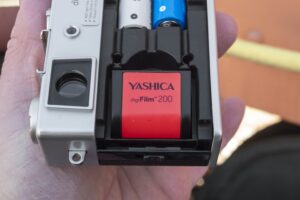
Where I might deviate from some of these other reviews (or maybe just enough time has passed that I am looking at this camera more objectively) is in the concept of “digital film”. Yashica, or more specifically, 100 Enterprises International Group Company Limited, the company who made it, promised a film like experience but in a digital camera, and I must say, the concept actually works.
When I think of every digital camera I’ve used, the most “film like” digital camera is the Epson R-D1. Built by Cosina on a body that the Voigtländer Bessa film rangefinders were based on, using the Leica M-bayonet mount, featuring the worlds only other digital camera which requires you to manually cock the shutter, and a large analog control panel which looks like an analog Seiko watch, the Epson R-D1 has almost all the appeal of a film camera, except it is digital. While I’ll stop short of saying the Yashica digiFilm camera Y35 compares to the Epson R-D1, I will say they both recreate the film experience in a digital camera in much the same way.
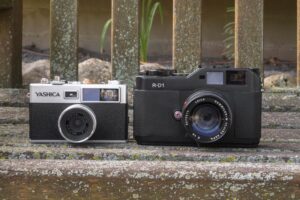
While a certain kind of knee-jerk reaction is to be expected when I declare that the cheap plastic Yashica digiFilm camera Y35 shares something in common with a precision built, high spec digital rangefinder camera like the Epson R-D1, hear me out.
If you were tasked with designing a digital camera that recreates the film experience, what features would you incorporate into it? Styling which evokes a classic film camera? Check. A film advance lever? Check. No ability to review your images? Check (sorta, the Epson does have a screen, but you can swivel it away and it lacks an EVF). A limited range of settings? Check (again sorta as the Epson does still technically have the ability to change things like ISO speeds and color/B&W on the fly, but its not easy.)
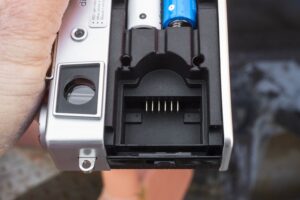
Where the Yashica digiFilm camera Y35 really differs is in the digiFilm cartridges, which many people complained were unnecessary and gimmicky. If you think about it though, with most film cameras (magazine cameras excluded), once you load in a roll of film, you are stuck with that speed and style of film until you are done. Sure you can rewind film and change some rolls midway, but for the average point and shoot user which the Yashica is going to appeal to, being limited to just what the cartridge your using gives you, is a very film like experience. If you want to change film speeds or go between black and white to color, you can change the cartridge mid roll, but its still an extra step, an analog process that a typical digital camera doesn’t require.
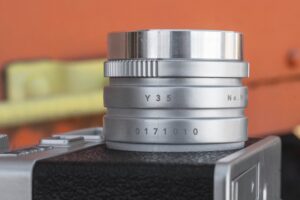
Yes, the digiFilm cartridges are gimmicky, but for me, that was part of the process. While out shooting, I thought of which cartridge I had in the camera and asked myself, will this make a good image? What if I want to change to something else? It slowed me down and made me think of my composition much in the same way a true film camera would. By separating the “settings” of the camera into an extra manual step gave the camera a more analog experience, which I actually liked. While out shooting, I felt challenged by which cartridge I was using, looking for images which would fit what I had, and if I wanted to shoot something else, I could still do that.
The lack of an LCD screen or an EVF removes the temptation to review and self edit myself while out shooting. While a 32GB memory card in the Yashica would offer far more exposures than any film camera could ever have, I still felt economic in my presses of the shutter release. I resisted the urge to “spray and pray” like most digital photographers do. After taking the camera home and plugging it into my PC, I felt as though I had more ‘winners’ and less throw away pics.
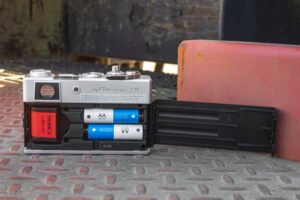
Other minor things I appreciated about the camera was that it uses regular AA batteries. I don’t have to try and find an expensive lithium 2CR5 battery, or worry about recharging a built in lithium-ion battery. I appreciate the red/purple status light on the back which acts both as a power on and readiness indicator that it is ready to make an exposure. Finally, I was quite impressed with the camera’s range of shutter speeds. With a range of 1/30 to 1/6000 seconds, I’ve used many much more capable cameras that couldn’t come close to those speeds.
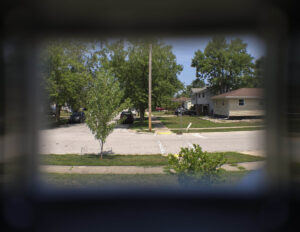
The Yashica digiFilm camera Y35 certainly isn’t perfect. In addition to its cheap build quality, another really annoying thing is that the action of pressing the shutter release and the shutter actually firing is disjointed. A short delay exists between when the shutter actually fires and when the button is pressed. Yashica even went as far as to give you an audible “shutter sound” but this doesn’t help either. This delay from when you press the shutter release, expecting the image to be made, and when it actually is made, results in many blurred photos, especially in low light scenes where longer shutter speeds are being used. If you look in the gallery below, there is an image of me in my car’s rear view mirror. Notice my finger isn’t even on the shutter release, as I had already pressed it down and lifted up my finger by the time the shutter actually fired. In this instance, the image wasn’t blurred, but I had many that were.
This being a digital camera, I did not have to wait and find the time to develop film and then scan it into my computer. I was able to get some instant gratification by plugging it into my PC and transferring the images over. Looking at the first sample images, I was initially impressed with the image quality. Sharpness from the 5-element f/2 lens and 14.0 megapixel sensor was better than the cheap build quality of the camera suggested. Sharpness was pretty good across the frame, and while there was some vignetting outdoors, it was the good kind that people who love vintage cameras would appreciate.
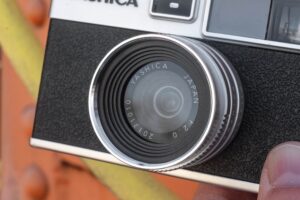
Colors were vibrant, but probably not very accurate. The Yashica digiFilm camera Y35 offers cartridges with intentionally muted or altered color schemes, but I preferred the look of the digiFilm Color 200 over the other color options. My favorite cassette however, was the black and white cartridge. I felt that the monochromatic images resulted in the nicest looking images. If you look at my B&W images below, you may notice that they’re not truly black and white, but rather are monochrome color images with a slight greenish hue. This is consistent with chromogenic black and white films like Kodak BW400CN, which is a black and white emulsion designed for the C41 color process. I could have easily removed this green cast in post, but decided not to.
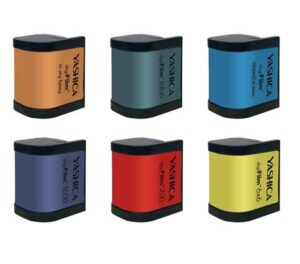
Optically, the biggest flaw was extreme barrel distortion. And when I say extreme, it is probably the worst I’ve seen on any camera. Straight lines are nearly impossible to make. Even more frustrating is the curvature of the lens isn’t consistent from side to side. I noticed more curve on the left side of images than the right. See the color photo of the comic book shop below, the bottom two shelves curve strongly upwards on the left and only a little on the right. It is also noticeable in the black and white image of my camera shelf.
I might have been more forgiving of this distortion if I wasn’t keenly aware that cell phone cameras have high megapixel sensors and don’t exhibit as bad of distortion as the lens does here. While I can’t prove this, I sincerely doubt that 100 Enterprises International Group Company Limited created a 5-element glass lens specifically for this camera, rather, this was probably a parts bin lens from something else like a dashcam. I would have guessed that a consumer grade cell phone camera from 2018 would have performed better than this.
And speaking of the sensor, I have my doubts that this sensor is unique to this camera as well. In my research for this review, I attempted to find a source of information stating where the 1/2.5″ CMOS chip is from, but I came up short. Almost certainly, this is a CCTV sensor designed for surveillance systems. Such devices almost always use a “System on a Chip” module which looks very similar to the one seen in the Point & Shoot Club tear-down video. Doing a little digging around, I found many examples of SoC CCTV devices with 1/2.5″ CMOS chips, all of which had 8 megapixel or lower sensors. I found no evidence of any that produced images as large as 14.0 megapixels. This strongly suggests that perhaps the chip here is an 8 megapixel or lower design, and the final image is interpolated to 14.0 megapixels.
Why 8 Megapixels? Most CCTV camera sensors are designed for video applications. In the video world, the most common “high-end” video systems top out at 4k, which in terms of pixels is 3840 x 2160. If you pull out your calculator and multiply those numbers together, you get roughly 8 megapixels. Since this is the maximum resolution of nearly all affordable video display devices, it makes no sense to develop sensors that can go any higher.
Still, with a less than inspiring performance from the lens, and a possible CCTV quality digital sensor with digitally interpolated images, I must admit, the images still weren’t that bad. I was quite pleased with many of the shots I made and found that they would be more than passible if shared on social media sites, or printed at 4×6 or 5×7 sizes. Certainly, this is not a serious camera, so the images should be judged accordingly, but overall, I did not hate the results.
This brings me back to my original point that I think the Yashica digiFilm camera Y35 faithfully recreates the film experience, in the sense that the images will be a grab bag of quality. You won’t know exactly what you’re gonna get until after you get the images home. That certainly wouldn’t be good news for a professional photographer used to a Nikon D850 or a Sony A7R V, but its going to be in line with someone looking for a cheap plastic point and shoot.
This is the point in most of my reviews where I give my final thoughts on a camera. Is the Yashica digiFilm camera Y35 worthy of adding to your collection? The answer to that question is “it depends”. On one hand, the Y35 offers a combination of features that is unlike nearly every camera ever made. Only the Epson R-D1 offers what I would describe as a true hybrid film and digital shooting experience, but that is a two decade old camera with prices out of reach for most collectors today.
The Y35 is a neat camera and is also one of the few crowdfunded cameras that met both its original goal, plus all stretch goals and was delivered on time. The developers might have embellished a little on what the camera could do, but they never lied. The Yashica digiFilm camera Y35 does absolutely everything it was promised to do, and the images it makes aren’t that bad. With current eBay prices anywhere from $150 to $400, if you fully understand what this camera is, and can find one on the lower end of that price range, I think it is worthy of taking a chance on, even if just to experience it. On the other hand, if you are looking for a well built and dependable point and shoot digital camera for frequent use, you will definitely be disappointed.
I did end up liking the Yashica digiFilm camera Y35 more than I expected, but if there is one thing that bothers me the most about it is that I think that with a few small changes, the camera could have been a lot better. If I had the benefit of a time machine, and I could convince the designers of this camera to make three critical changes, I do believe the perception of this camera would have been much different.
-
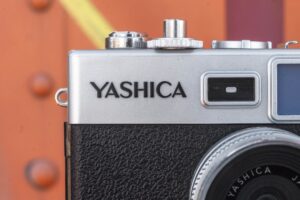
I think calling this a Yashica camera was its biggest mistake. I believe it would have been better received if it didn’t have the name of a reputable company. My first change would be to not call this a Yashica or give it a retro design of any existing film camera. This camera is a curiosity, the people who are most likely going to buy something like this are younger photographers looking for that “film shooting” experience, but with the convenience of digital. These people almost certainly have never heard of Yashica, nor have they ever seen the Electro 35 camera it loosely resembles. The fact that this has a well known name would be meaningless to those who would be most likely to buy it.
Of the people who do remember Yashica and might fondly remember the Electro 35, this camera is not that camera. The build quality, simplistic interface, questionable lens and shutter operation will all be turnoffs to anyone who fondly remember Yashica. That this camera was built as cheaply as it was, and has the feature set it does, giving it the name of a well known camera brand feels like a slap in the face to collectors. I believe that if this camera had a more generic “retro” design with a name that didn’t harken back to any legacy brands, it would have been received much better.
- The build quality needed to improve. I don’t know much about the different types of plastics out there, or how things are manufactured on a large scale, but I have handled my fair share of plastic cameras, and this one is the lowest of the low. If the materials used in this camera were needed as a requirement to hit its price point, then they should have raised the price point. I can’t believe that a slightly higher plastic with a rubber feeling body covering and maybe some cheap metal parts would have added more than $10 – $20 to the build cost of this camera. Pass that directly onto the consumer, and a $20 more expensive camera made of higher quality materials would have gone a LONG way towards improving the camera’s tactile feel. And since we’re talking about build quality, even if improving the feel of the camera was a non-starter, they must do better with that shutter release, it is absolutely terrible!
-
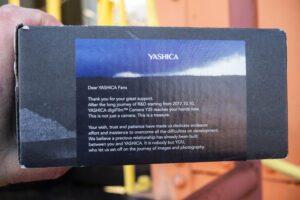
Each camera has this inspiring message printed on the side of the box. Give it a better lens. On paper, a 5-element lens with a maximum aperture of f/2 sounds amazing, but in performance it isn’t. Images that strangely curve only on one side of the camera and have strange color aberrations isn’t what people expect from such an advanced lens. In terms of available lenses, billions of cell phone camera lenses have been made which cost pennies. I can’t believe that there isn’t a stockpile somewhere of NOS Samsung or OnePlus camera modules that they could have used. This camera could have had a circa 2017-18 smartphone camera inside, and it would have been more capable than this. Much of the negative press around this camera surrounds its cheap build quality, but if the images were better, I think people would have been far more forgiving.
- Okay, I know I said 3, but I’ll add that this should have a USB-C port for data transfer. Micro-USB needs to die!
So, there you have it. My first ever review of a crowdfunded camera, and the least old camera I’ve ever looked at. While the Yashica digiFilm camera Y35 was never one I had on my radar, I am glad I took the chance on it. This is a curious concept that I think is worth revisiting. I would love to see someone make an honest attempt at something in between the Y35 and the Epson R-D1. Give us a serious digital point and shoot with some film like attributes which blend the best of both worlds, and I actually think it would be successful. If any company is reading this and wants to give it a go, send me a message and I’d be happy to test it out for you!
Related Posts You Might Enjoy
External Links
http://camera-wiki.org/wiki/Yashica_Y35
https://www.yashica.com/y35-learn-more
https://www.kickstarter.com/projects/1940283777/expect-the-unexpected-digifilmtm-camera-by-yashica

